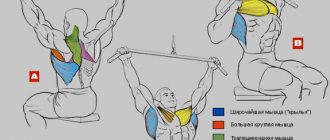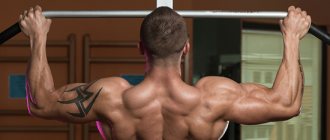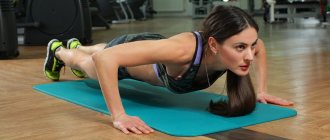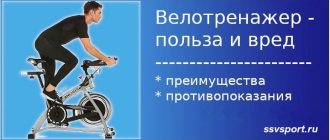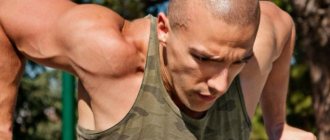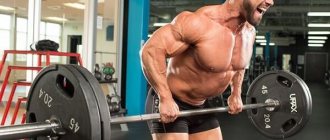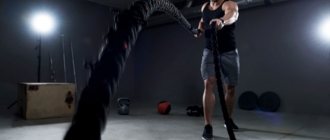Common mistakes and how to avoid them
When you do hack squats, the load is placed on the muscles and joints of your legs. The most vulnerable joints in the legs are the knees
Therefore, it is important to avoid mistakes, which we will now talk about:
- Knees point inward. You can't imagine what your knees feel like at this moment. You can easily tear the ligament and damage the cartilage. Therefore, we turn our knees to the sides. It is desirable that they are oriented in the same direction as the feet.
- When performing the exercise, the pelvis “walks”. You can get an intervertebral hernia. Press your buttocks into your back.
- The head is lowered down or raised up. The spine should be straight, with all natural curves. This way it is the strongest and can withstand heavy loads without harm to you. When performing hack squats, the load on the spine is less than with the classic version, but it is still there.
- We go down as we inhale, we rise as we exhale. The maximum load occurs when your lungs are full. This is fraught with a sharp increase in pressure in them. Of course, it’s unlikely to come to a rupture (you’re not squatting 300 kg in a hack, and whoever squats breathes correctly), but you will cause harm to the body. Remember that we stand up as we exhale. And nothing else.
- When we sit down under the weight, our heels lift off the platform. If it's because of your stretch, don't squat until you've stretched to the desired extent. If this is a feature of the body, and no matter how you stretch, there is no point - use the leg press.
- Sneakers. It is unacceptable to squat in sneakers with high and soft soles. It is best to wear weight shoes and sneakers, which must be closed. No flip flops or slippers. Shoes should be rigid and with thin soles so that the foot stands stable even under increased weight.
Squats in bodybuilding. Benefits and harms
The squat has the following beneficial properties:
- Accelerated muscle growth for the whole body;
- The best and indispensable exercise for girls, with the help of which a feminine figure is built;
- Improves mood and psychological state. Hormones of happiness from overcoming stress are released into the blood, as well as anabolic substances that promote activity, enterprise, and increased energy;
- The knee joints are strengthened. This is especially true for people who lead a sedentary lifestyle. What is not used quickly becomes unusable. The benefits of squats here are relevant only for correct technique;
- The ability to improve proportions “in one fell swoop.” The squat works the entire lower body. Many men are not focused on the development of the upper body; prejudices interfere with the uniform development of muscles. Lower body exercises like lunges seem feminine. Squats are an exercise that even the most courageous men use;
- Improving blood circulation in the pelvic organs. Squats prevent the development of male diseases such as prostatitis and increase libido. Read more here.
Squats in bodybuilding can be harmful due to the following properties:
- Wear and tear of the knee joints due to improper technique. Weighted squats wreak havoc on men and women with sore joints;
- Growth cessation in adolescents. Significant weight (more than 40 kg) under the age of 18 puts a compressive load on the spine, which slows down height growth and provokes the development of scoliosis;
- Injuries due to incorrect technique.
The harm of squats, for the most part, lies in the incorrect use of the movement.
Basic rules and recommendations
It's never too late to listen to the advice of experts. To successfully perform squat-based exercises, you need to take into account some important recommendations:
- It is necessary to start exercising (especially with any weights) only after a good warm-up.
- The main rule is a perfectly straight back, even with a slight arch in the lumbar region. It is strictly forbidden to round your back, as this can lead to injury.
- Do not turn your head, do not lower your chin down or lift it up. You need to keep your head straight and look ahead.
- The feet and knees should be parallel to each other in all squats except plie and sumo. But in any case, the knees should not “go” inward.
Watch the angle of your hips in relation to the floor, as the muscle groups being worked depend on this (in classic squats, this angle is 90°); The correct position of various points of the body in relation to each other is important. So, socks, knees and shoulders should be on the same vertical line when lowering the pelvis
Don't lean forward too much and don't fall back. Stand with your full foot resting on your heel. When performing, watch the speed of movements. So, it takes longer to go down than to go up. On average, it takes about 3-4 seconds to lower the pelvis, and the rise should be quick. At the lowest point, you can fix the pelvis for a second, after which you can strongly push it up, focusing on your heels. When using a barbell, make sure that it is not on the neck, but slightly lower - at the top of the trapezius. When using dumbbells or kettlebells held high or low in front of you, always keep your shoulders fully squared and slightly back to distribute the weight evenly across your pecs.
Take a suitable weight limit. Too small will not give the desired result in extension; too large, in which the execution technique suffers, and can injure. The weight should be such that you can do a small number of approaches, but correctly. If your goal is not to build muscle, but to lose weight and tone your muscles and create relief, then you should not exercise with weights. Dynamic exercises that burn calories and a high number of repetitions will be enough. Jump squats are ideal for this. To make sure your exercises are as effective as possible, pay close attention to your body.
Always focus on the muscles you are working on. With such concentration, you will feel them better, you will be able to feel whether they are involved; feel where the center of gravity is and how the weight is distributed
This will help you perform the exercises technically correctly and avoid mistakes.
Proper breathing in squats is as important as the technique. You need to breathe as follows: inhale while lowering the pelvis down and exhale while fully lifting up.
Important! The mechanics of breathing are such that when you exhale, the muscles of the peritoneum relax, and when you inhale, they form into a corset in which the stomach, chest, and back are grouped
It is this kind of muscle corset that is necessary when pushing the pelvis upward.
What types of squats are there?
Classic squats
Regular squats - the so-called variety of exercises with your own weight (without the use of weights) - bring a tremendous effect for the hips and buttocks. The main thing is to learn the correct technique to specifically pump up your butt and thighs, and also minimize the risk of injury.
The nuances of performing this exercise for losing weight on the legs and buttocks:
- Starting position – feet at a distance greater than shoulder width, toes slightly turned outward, back straight, head not tilted forward.
- As you inhale, move your pelvis back, slowly bending your knees. Lower yourself to parallel with the floor or slightly lower.
- The back should be almost perpendicular to the floor, only a slight forward bend is allowed. The knees should be positioned so that the shins, thighs and feet are strictly in line.
- At the bottom point, you need to linger for a couple of seconds, then rise at the exit, significantly straining your buttocks.
- At the top point, you cannot fully straighten your knees, because this is very harmful to the joints!
It is necessary to perform 3 sets of 15-20 squats. If you are a beginner, you can get by with 3-4 sets of 10 repetitions.
Squat with weights
You can use any type of apparatus that you like best: a barbell, a barbell, only weights, dumbbells, two small weights or one heavier one. The rules of the squat remain the same in any case.
Technique:
- Walk up to the rack and squat so that the bar touches the trapezoid, if using a barbell. The kettlebell should be held with both hands below in front of you, with dumbbells - straighten your arms and keep them on the sides of your body. With your feet shoulder-width apart, hold the projectile securely.
- Keeping your back straight, you need to squat down so that your thigh is parallel to the floor. The pelvis must not be tucked forward!
You need to perform two or three approaches. For beginners, it is better to squat shallowly and do no more than ten repetitions; advanced ones can gradually increase the number of repetitions up to twenty times. Keep in mind that when squatting with dumbbells or small kettlebells, the implements can be held in front of you, brought to your shoulders, or raised high above your head, but these additional movements require good coordination. Squats with a barbell also need to be done carefully: look forward at a point on the floor so as not to lose your balance and fall, dropping the bar on yourself.

Plie squats for inner thighs
The plie squat specifically works the inner thighs - it stretches and pumps small muscles, which has a beneficial effect on the appearance of the thighs and overall flexibility. This complex works the gluteal muscles, legs, arms, abs and even the back.
How the exercise is performed: squats with or without apparatus
- Your feet should be shoulder-width apart, with your toes turned slightly outward. You need to straighten your back and keep your head level.
- The most important rule is that the buttocks should not fall below the knees during a squat, because in this case the main load will be transferred to the knee.
- To maximize the use of the gluteal and quadriceps muscles, you need to shift your body weight much further back.
- It is necessary to lower while inhaling, to rise while exhaling, crossing your arms behind your head.
The frequency of exercise should be selected individually, taking into account the goal - you also want to lose weight, add a little flexibility to your muscles, or give your legs the desired shape. Most often, experienced specialists recommend starting with 3 sets of 8 squats, gradually increasing the number and only then the number of approaches. Sometimes you can press weights or plates to one leg, then to the other, to alternate the load. But it is better for experienced athletes to do this. Ultimately, you can increase the number of squats to 4 sets of 15-17 times.

What muscles work
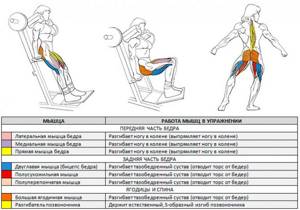
The main movers here are the quadriceps and hamstrings. With a good amplitude, the gluteal muscles are included in the movement. The calves and soleus also work in this squat variation. It is a mistaken belief that the Hack squat is for beginners. An ordinary person with an office job does not have the necessary mobility in the ankles and hip joints and therefore should not squat in the Hakka.
The error occurs because the simulator turns off the abs and back. Many people find it easier to squat this way. However, such a squat is not natural for a person. In everyday life, we sit down and stand up with a slight tilt of the body forward with contracted back muscles. We need to activate these muscles to maintain balance.
The back is turned off not to prevent injury or for rehabilitation, but in order to achieve bodybuilding goals. With the help of the Hack squat, they want to “turn on” the legs and “turn off” the transverse abdominal muscles and latissimus dorsi muscles as much as possible from the process. This is necessary in order to get a load that does not increase the width of the waist. This is all true only for professional athletes, their training volumes and means of recovery. But an ordinary amateur who came to strengthen his muscles and improve his appearance, but not become a bodybuilder, should not worry about this. He is still not destined to “swing his waist” with ordinary strength exercises.
Varieties of squats
Squats can be divided into three main types: powerlifting, bodybuilding and weightlifting. They all work the muscles a little differently. For example, weightlifting squats are deeper and difficult for beginners. A lot of muscles are involved, you have to put in maximum effort. You need to do them deeply.
Powerlifting squats are done to parallel, sometimes even lower. The impact on the gluteal muscles occurs to the maximum. And the bodybuilding version is performed above parallel, the thighs are worked out well. But still, it is the powerlifting option that is more suitable for beginners.
If you want to build muscle mass, then you should take a closer look at barbell training. The barbell will help you increase the load by working the muscles of the buttocks and quadriceps to the maximum. At the same time, the soleus and adductor muscles of the thigh are also worked out. And the hamstrings, calves, abs, and back extensors work as assistants. In this case, experts recommend performing exercises with heavy weights and at an intense pace.
A variety called plie is popular; girls especially love this type of squats. These are isolation exercises. The buttocks, hamstrings, and inner thighs, which are often problematic, are worked on. But it is better to perform exercises with dumbbells, since the barbell does not complement these exercises well. Only from the point of view of human anatomy, this type is unnatural, because when it is performed, the entire load goes from the quadriceps to the biceps of the thigh and buttocks. But at the same time, this is precisely why the exercises are effective.
During plié, the soleus muscle also works - it is responsible for your support. Dumbbells take the load off other groups
The biceps work to a small extent, but the spine is unloaded - this is very important. The knee joint also takes part, which is why plies are effective and so beloved by many girls
httpv://www.youtube.com/watch?v=embed/h6oxpPpO0bQ
Types of squats
Classic squats with a barbell on the shoulders
Designed for the development of quadriceps, buttocks, and spinal stabilizer muscles. This technique allows you to constantly increase the degree of load, so only trained athletes should perform this type of squats. You can perform squats at different depths.
To the parallel. This option is the least dangerous for the knee joints and lower back. The lowest point of a squat is the moment when the pelvis reaches the level of the knees and the thigh becomes parallel to the floor.

Deep squats. This type requires flexible muscles, ligaments and sufficient joint mobility
The knee joints are subject to a lot of stress, so it is important to maintain the correct squatting technique. This option puts more strain on the gluteal muscles, due to their maximum extension and greater range of motion.
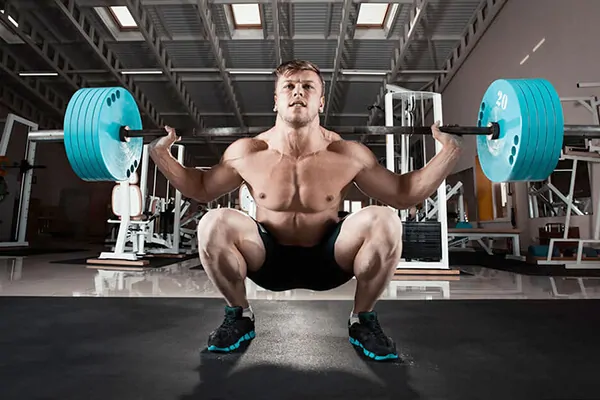
Front Squats
Such squats shift the center of gravity from the heels to the toes, thereby placing a greater load on the quadriceps of the thigh.
Squats with dumbbells or kettlebell
These types of equipment make it possible to perform squats for those who are not recommended to receive a compression load on the spine, this is associated with various injuries and diseases of the spine.
The weight is held in the center with both hands;
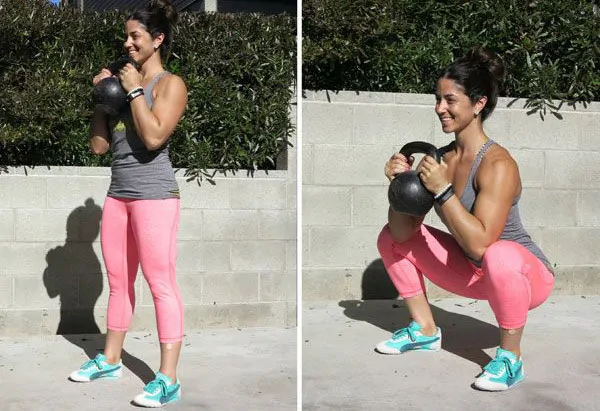
and dumbbells along the sides of the thighs.

Wide leg squats (sumo)
Allows the development of predominantly the entire adductor (inner) surface of the thigh. The atonic state (weakness) of the adductor muscles does not make it possible to fully perform all types of squats and keep the knees at one point, so the exercise improves their stabilizing function.
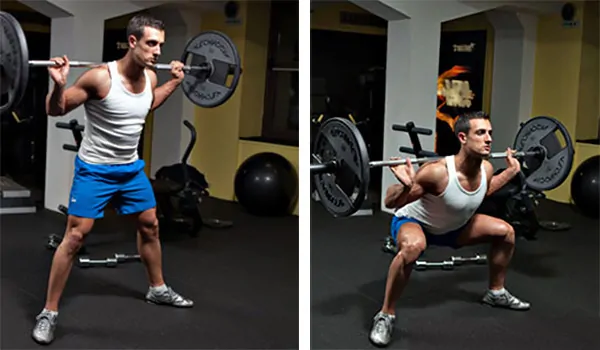
But girls should not get carried away with this type of squats, as it develops the volume of the adductor muscles, which makes the look less aesthetic.
Narrow leg squats
This option develops the outer thigh (abductor muscles). This is especially necessary for those who want to achieve impressive volumes of the quadriceps muscles. The buttocks work to a lesser extent in the exercise, since the squat cannot be performed deeply.
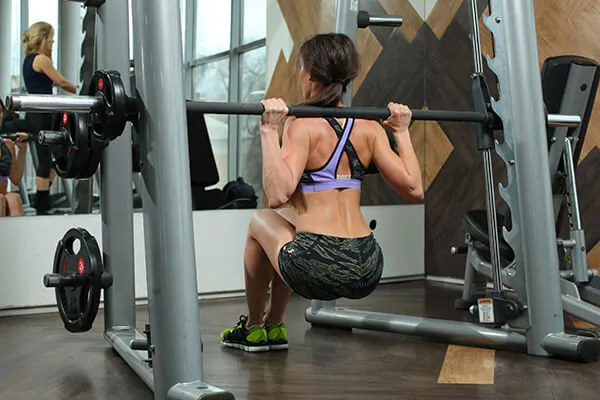
Plie squats
Similar to the sumo technique, plies maximize the development of the adductor surface of the hips. The feet are placed as wide as possible, the knees and toes are turned apart.

Single leg squats
This technique is performed with a wide stance of the legs without turning the toes, the feet are parallel to each other. When squats, the center of gravity shifts to one leg, bringing one knee to a right angle, while the other remains straight. The technique is complicated by the fact that the load falls on only one leg, and not on both at the same time. This technique develops not only the adductor, but also forms the abductor surface of the thigh.
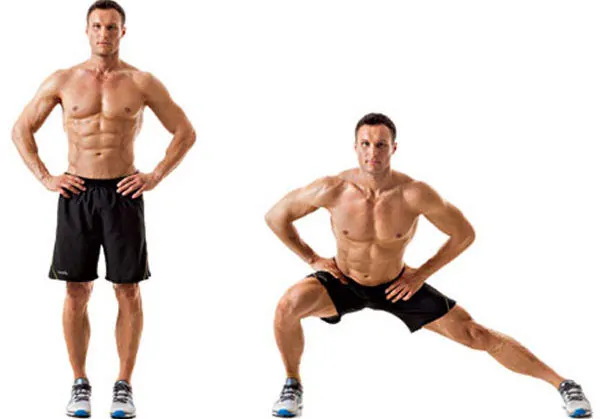
Sissy squats
Performed with dumbbells or without weight. The peculiarity of the exercise is that when squatting, only the knee joint bends, and the hip joint remains motionless, maintaining the position of the hips and torso in the same plane. The lower parts of the quadriceps develop to a greater extent.
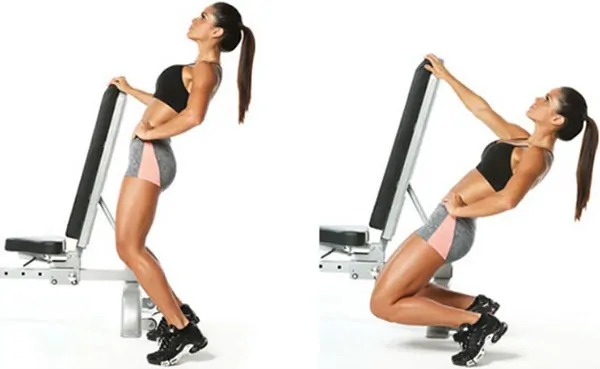
Pistol
It is performed on one leg; when squatting, the joints of the legs are subjected to a large load, therefore, in order to develop coordination and strength of the leg muscles using this technique, it is necessary to have high flexibility of the ligamentous apparatus.

Smith machine squats
They allow you to shift the main part of the load from the back muscles to the legs, allowing you to develop your hips and buttocks without compression of the spine. Foot placement and bar position are similar to barbell squats.
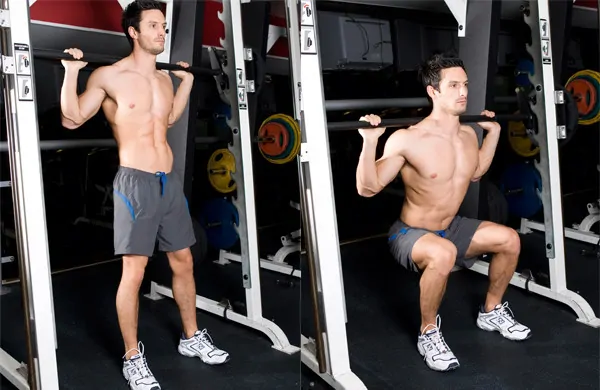
Hack squats in the machine
The exercise is performed in two ways of placing the feet - medium and wide. A special simulator shifts part of the load from the legs to the back. The exercise can also be performed with a barbell behind your back.

Squats with extra weight
Squats with a barbell will help you gain muscle mass in your legs . The extra weight will put enormous stress on your hips, which will make them bigger. The classic version is squats with a barbell to parallel. When this exercise is written in training programs, they mean the squat to parallel. It has a very good effect on the quadriceps and hamstrings. And also, thanks to the weight of the barbell, the lumbar muscles actively work. This exercise must be performed in 4 sets of 8-12 repetitions.
A deep squat with a barbell is a rather traumatic exercise for the lower back and knees . However, you should not neglect them. If you warm up well and take a weight that is 40-50 percent less than the working weight, you can work out your buttocks very well. The main thing is to follow the technique and not chase the scales.
Leg placement in a squat plays a very important role. The wider it is, the more tense the buttocks and hamstrings become. And the wider, the more the quadriceps work. A very good option for leg training is alternating approaches with different leg widths. That is, in the first approach you place your feet slightly wider than shoulder width. And in the second, a little narrower. By training in this way, you will evenly distribute the load on all the leg muscles.
In addition to the classic barbell squats, there are 2 more variations of the squat with additional weight:
- Front squats.
- Dumbbell sumo squats.
Front squats should not be done by beginners. This movement is very dangerous for the spine. When performing it, you need to take much less weight than you take with a classic squat. This version of the exercise involves the quadriceps femoris and lumbar muscles.
You cannot squat below parallel level. It's better to even squat just above this level. This version of the squat is contraindicated for people who have problems with their knee joints and back. It should be performed in 3-4 sets of 12-15 repetitions.
Sumo style dumbbell squats are more suitable for girls. By performing this exercise, you can achieve firm buttocks and beautiful hips that will attract the attention of men. Sumo squat technique:
- The legs are spread wide apart, the lower back is arched.
- Your feet are turned out to the sides.
- You are holding a dumbbell in your hands.
- Slowly squat to parallel level.
- At the bottom point, hold for 3 seconds. Feel the tension in your hips and buttocks.
- Rise up smoothly.
This exercise should be performed in 4 sets of 12-15 repetitions. Make sure your lower back is always arched. Do not hurry. The whole point of this exercise is to feel the muscles working.
The weight must be chosen so as not to violate the execution technique. The optimal weight for beginners is 8-10 kilograms. Over time it is necessary to increase weight. This is exactly what you need for muscle growth.
How to increase your barbell squat?
Every second gym goer wonders how to increase a barbell squat. There are many methods, but the point is always in two aspects: proper cycling of loads (using percentages and alternating light/heavy training) and performing auxiliary exercises. In practice, a competitive powerlifter will typically do two squat workouts per week, one with a weight equal to 50-60% of the maximum for 5 reps for three sets, and the other with a weight equal to 75-85% of the maximum. maximum, 5 repetitions in five approaches. Closer to the competition, the weight of the bar increases, and the number of repetitions decreases.
When it comes to accessory exercises, the most commonly preferred exercises are pause squats, front squats, barbell bend-overs, bench squats, and overhead squats.
- Pause squats are a type of squat in which the athlete works at the deepest possible amplitude, fixating for a few seconds at the lowest point. The upward movement is explosive in nature, thereby significantly increasing the speed of the lift during normal squats.
- Front squats differ from classic squats with a barbell in the position of the bar - here it is on the chest. Thanks to this, the vector of movement changes slightly, and the quadriceps receives a more serious load.
- Bent-overs are extremely important for strength athletes because they help keep your core more stable during heavy squats.
- Bench squats are a type of squats with a shorter amplitude (we lower ourselves above parallel), where our task is to lower ourselves to the level of the bench.
- Overhead squats are a coordination exercise that are quite challenging for beginners. Helps you get a better feel for corners and blind spots.
» alt=»»>
httpv://www.youtube.com/watch?v=embed/zG-MeFbhQc8
What muscle groups are involved?
In order to choose the right set of exercises for yourself, and it will be effective, you need to know which muscles work during squats. The main ones are:
- The quadriceps femoris (quadriceps muscle) is the front part of the thigh. She is responsible for ensuring that the leg straightens at the knee joint.
- The biceps femoris (biceps muscle) is the back of the thigh, responsible for bending the leg at the knee and straightening at the hip.
- The adductor muscles of the thigh are the inner surface of the thighs. Helps move the leg to the side.
- Gluteal muscles - large, medium and small. Multifunctional, responsible for all movements of the lower half of the body.
- The gastrocnemius and soleus muscles are the lower legs. Participate in maintaining balance and promoting upright walking.
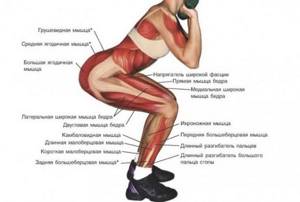
Additional stabilizer muscles that work during squats also perform important functions:
- Dorsal. Helps maintain a straight back during exercise. Mainly the muscles of the lumbar region are involved. However, with the correct distribution of the load and center of gravity, the back should only be responsible for its even position. The back muscles are not pumped during squats, as this is ineffective and unsafe.
- Press. Only the lower and middle ones are used. Responsible for maintaining the peritoneum in tone and forming a muscular corset around the internal organs, helping to maintain position and balance.
Did you know? In men, weighted squats increase testosterone levels.
The muscles involved in squats are the same in both men and women. There are no anatomical differences when performing the exercise. However, differences in muscle architecture between the sexes are obvious. This is not due to the different influence of squats on muscles, but to the fact that men and women set different goals in pumping and therefore work on different muscle groups. The differences in how squats are performed determine which muscles are affected and which ones will grow or change their definition accordingly.
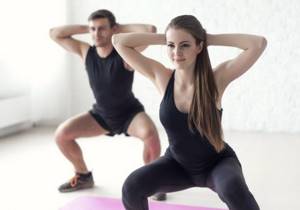
So, guys first pump up their quadriceps and hamstrings, as well as their calves. They don't need rounded buttocks. Therefore, they perform exercises that are most effective for the leg muscles (for example, plies, squats with legs together, or high squats with a barbell). The quadriceps swing precisely when the pelvis is lowered - so that the thigh is parallel to the line above the floor.
Read more about the benefits of squats for the body of men and women.
Girls have different goals. They strive to form rounded buttocks (and this is possible if they develop the gluteal muscles as much as possible). To achieve results, squats are used with a deep lowering of the pelvis and moving it back (for example, “sumo”).
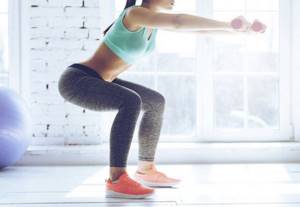
Beginners who have only recently started using such exercises in their training are interested in which muscles should hurt after squats. For example, girls wonder why their buttocks don’t hurt after training. The fact is that the part of the body that worked will hurt. This answer to the question concerns not only representatives of the fair half of humanity.
Important! Painful sensations should be present in all muscles that were involved in each specific exercise. Pain will occur, but only if the muscle fibers have received maximum load.
Types of squats and muscles
In fitness, there are many different squats that target specific muscle groups. Let's look at the most popular and accessible to everyone:
- All 4 heads of the quadriceps, the lumbar region and buttocks are pumped while building strength in squats with a barbell. This exercise can be perfectly performed by short people, as practice shows.
- Plie squats effectively train the inner thighs. The difficulty of doing this is that you will need good coordination.
- Powerful basic work of all muscles of the lower body is ensured by sumo squats with wide legs. This exercise is great for beginners, teaching proper technique while putting minimal stress on the knee joints.
- One of the most rare exercises in the gym are frontal exercises with the barbell placed on the chest. The main load is directed to the quadriceps, the auxiliary load is distributed to the calves, buttock muscles and hamstrings.
- You can perform heavy squats with dumbbells - they are placed on the shoulders and below in the lowered arms. The buttocks, front and back surfaces of the thighs and a little back with the abs are loaded.
- Bare squats are suitable for improving overall fitness, but not for building muscle mass.
- By squatting on one leg, the muscle mass develops collectively, showing how strong your legs are.
- Narrow stance of the legs during squats puts increased stress on the quadriceps - the front surface of the thigh. But the buttocks do not receive enough of it due to the inability to squat deeply.
To maximally work out muscle groups, you need to have knowledge of the correct technique and strictly follow it. I do not recommend deep squats for women and girls who want to lose excess weight - such workouts, and even with the use of additional weights, are suitable for men to build muscle mass.
Start small - 2 approaches, in each of which you need to squat at least 12 times, gradually reaching 3-5 with the number of repetitions up to 20-30.
Do not forget to also regulate your diet, which is an integral part of the entire process of shaping your body.
How to make specific muscles work?
Please note that the main rule applies here, on which not only the effectiveness of the training depends, but also the health of the trainee. Study the squat technique carefully and follow it strictly. Especially if you are going to lift heavy weights.
Let's look at the types of squats and which muscle groups work in each case:
- The quadriceps works almost constantly, and the ideal exercise for its 100% load is the classic squat with a barbell on the shoulders. Front squats (barbell on the chest) give the same effect, but cause less injury to the knees;
- When squats, where the legs are together, the muscles of the lateral and outer surface of the thigh work;
- Conversely, in squats with a wide stance, for example, plie or sumo, the inner surface of the thigh muscles works to a greater extent;
- If an athlete works with dumbbells that are placed in the lowered hands on the sides of the body, the back works harder than usual;
- Hack machine squats allow you to redirect the load to the outer thigh, you just need to place your feet a little wider than usual;
- To engage the upper quadriceps, place the bar directly in front of you on your bent elbows and squat down like this;
- What muscles do you think don't work during the Smith Machine squat? That's right, due to the absence of the need to control your balance, you will practically not use stabilizers. But make the task more difficult for the quadriceps.
Now you know what muscles swing when squatting in girls and boys. In conclusion, let's touch on one more topic.
Varieties of squats
There are enough exercises of this type to choose the ideal option for yourself, alternate between certain types of loads and harmoniously develop your body.
Barbell squats with increasing strength. Ideal for short people. Quadriceps, lower back, buttocks sway. "Sumo". These squats are characterized by a wide stance of the legs.
They put a load on the entire lower body, and its correct distribution occurs, which is very important for beginners. For sumo squats, you need to place your knees as wide as possible
This position provides stability and helps improve coordination during execution. "Plie". This is an ideal exercise for the inner thighs, which are not so easy to tighten. It is important to remember that it is quite difficult to maintain stability in this position, so coordination to perform it must be quite good. A difficult but effective exercise - with the frontal holding of a barbell on the chest. At the same time, the quadriceps are worked out, and to a lesser extent the hamstrings, calves, and buttocks. It is effective for “experienced” to squat with dumbbells pressed to the chest or in lowered hands. This makes not only the buttocks and back of the thighs strong, but also the back and abs.
Not every woman has the opportunity to visit the gym. This especially applies to mothers of children who find it difficult to leave home. I must say that they found a way out: many study in their own walls, using improvised means. If you take the correct position and do not disturb your breathing technique, such exercises will help improve your body.
httpv://www.youtube.com/watch?v=embed/TVX98wtjvFM
Exercise technique
In order for your training to bring as much benefit as possible, you need to master the technique of doing squats. However, you should know that the squat technique for men differs from that for women. This is due to the fact that girls want toned buttocks and a firm butt, while men focus on the quadriceps. This is why women do deep squats, and men lower their pelvis parallel to the floor and even higher.
Classic squats
Technique:
- Place your feet slightly wider than your shoulders and slightly arch your lower back. Toes and knees should be at the same level. Your arms can be extended forward or spread to the sides.
- As you inhale, lower your pelvis so that it is parallel to the floor.
- As you exhale, return to the starting position.
During a squat, your back should be straight or slightly arched. Your knees should be aligned with your toes, and your weight should be distributed evenly between your legs.
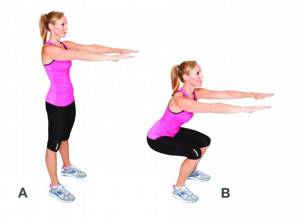
During classic squats, all leg muscles are trained evenly
Classic squats are also performed with a barbell:
- Raise the bar supports at shoulder level and place the barbell on them.
- Place your hands on the bar slightly wider than shoulder-width apart.
- Bend over so that the bar rests on your trapezius muscles and rear deltoids. The shoulder blades should be brought together.
- Remove the barbell while tightening your shoulders, arms, and back.
- Step back, place your feet wider than shoulder-width apart, and point your toes out at a 45-degree angle.
- Take a deep breath and tighten your abdominal muscles. Start squatting and move your pelvis back, but do not bend your back under any circumstances. It should be straight and slightly curved at the waist. You need to look straight, not up or down.
- When your pelvis is parallel to the floor, straighten up and exhale.
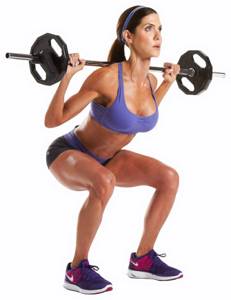
Squats with a barbell are a basic exercise that involves almost all major muscle groups of the body.
Video: how to do classic squats
Narrow leg squats
The technique of this type of squats is no different from the classic version. The only exception is that the legs are located close to each other. This exercise forms the quadriceps well and does not create a large load on the spine.

Narrow leg squats develop the outer thighs
Video: how to squat with narrow leg stance
Jump Squats
Technique:
- Place your feet shoulder-width apart and straighten your back.
- As you inhale, lower your pelvis and stretch your arms forward.
- As you exhale, jump as high as possible, while moving your hands behind your hips.
- Land softly on your toes and squat down again.

Jump squats carry both an aerobic and anaerobic load for the body
Most often this exercise is performed with your own weight. However, some athletes complicate the task and squat with dumbbells or a barbell. The weight of weights should be moderate, as additional weight increases the risk of injury. If you are squatting with a barbell, then position it in the same way as in the case of classic squats. And the dumbbells must be grasped tightly and held strictly along the body during squats and jumps.
Video: how to jump squat
"Curtsy"
Technique:
- Place your feet close to each other.
- As you inhale, shift your weight to your right leg and take a long diagonal step back with your left. The thigh of the supporting leg should be parallel to the floor, and the knee should be on the same axis as the tips of the toes.
- As you exhale, return to the starting position.

The peculiarity of the technique for performing such lunges is the additional stretching of the gluteal muscles.
There are several variations of this exercise:
- with a platform. Stand on the platform and lunge on the floor. This will increase muscle stretching;
- with dumbbells. Take small dumbbells and hold them along your torso. There is no need to bend your elbows during squats;
- with a barbell. Position the barbell in the same way as for classic squats and tighten your abdominal and back muscles. Your back should be straight during squats.
Video: how to perform a “curtsey”
"Balance"
Technique:
- Place your feet shoulder-width apart. Press one foot firmly to the floor, and place the other on your toes.
- As you inhale, lift your pelvis and do a squat. The weight should be on the supporting leg.
- As you exhale, straighten your legs and do the exercise with the other leg.
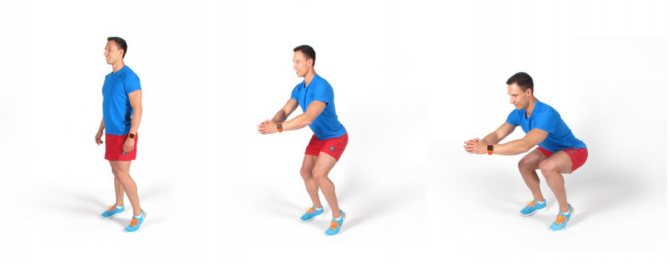
Balance squats are performed to increase the load
"Pistol"
Technique:
- Stand straight on one leg, and hold the other at a right angle.
- Inhale and squat, bending your supporting leg. The second leg is straightened parallel to the floor.
- As you inhale, return to the starting position.
For beginners, you can rest your hand on a chair while doing squats.
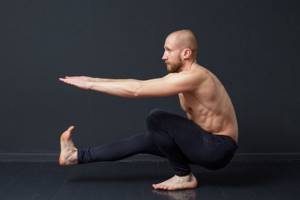
During pistol squats, the quadriceps are primarily worked out.
Video: how to perform the “pistol”
Plie squats
Technique:
- Place your legs wider than shoulder-width apart and turn your feet outward. Hands should be on the belt.
- As you inhale, move your pelvis back and bend your legs at an angle of 90 degrees.
- As you exhale, straighten up.
You can increase the load using dumbbells. They must be held between the legs.
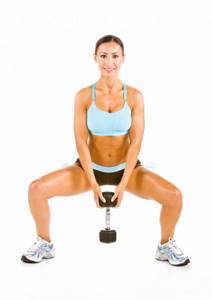
Plie squats are a basic exercise for targeting the inner muscles of the thighs and gluteal muscles.
Video: how to do plie
Technique for performing a deep squat with a barbell
Once you have mastered the technique of deep squats, you can use additional weights. Weighted squats will help build muscle mass in your buttocks and thighs. However, unless you are a professional athlete, doing deep squats with heavy weights is not recommended.
It is best to start working with weights in a Smith machine, since in this case it will be easier for you to maintain balance and perform the exercise correctly. After this, you can try squats with a light weight or an empty bar. In this case, the projectile can be placed on the back or on the chest.
Let's take a closer look at all three options.
Deep squats in a Smith machine for beginners and girls
Beginners should pay attention to this particular exercise, since here the apparatus is fixed, which eliminates the risk of falling back and makes it easier to place the load on the heels. To learn how to squat deeply, a safer starting option is Smith machine squats.
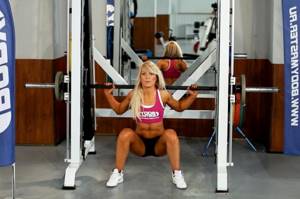
To learn how to squat deeply, a safer starting option is Smith machine squats.
Technique:
- We place the barbell on the upper back muscles, on the trapezius. Never place the bar on your neck.
- We remove the barbell from the clamps and take a half step or a step forward.
- Place your feet shoulder-width apart or slightly wider.
- Toes point straight or slightly to the sides.
- As we inhale, we slowly lower ourselves forward, do not dive, but gradually perform a squat.
- At the lowest point, we linger for a few seconds and, as we exhale, we slowly rise up.
- At the top point we tense our buttocks.
With the Smith machine, you can step far enough forward and perform squats without the risk of falling back because the barbell is holding you up. This allows you to sit up with your pelvis moving much further back than you would be able to with a regular barbell. Thus, the muscles are worked more deeply, and the load on the knees is reduced.
Start with 8-12 squats in 3 sets. Gradually increase to 12-15 times in 4 sets. Also, to build muscle mass, it makes sense to increase the weight of the projectile.
Video: Smith machine squat technique
httpv://www.youtube.com/watch?v=embed/poXUp3EF1Dw
Deep squats with a barbell on your shoulders
Before starting a workout, be sure to do a good warm-up to warm up your muscles. To prepare the lower back, which receives serious load during such squats, perform the hyperextension exercise in 2-3 sets of 15-20 times. Then do a few squats without weight and with an empty bar, and only then proceed with working approaches.

You should move on to deep squats with a barbell only when you have mastered the technique of the exercise well.
Technique:
- Step up to the rack and place the bar on your upper back and shoulders.
- We have a medium grip on the hands.
- Remove the apparatus from the racks and take a step or two forward or backward (depending on how the simulator is positioned).
- The gaze should be directed straight or slightly upward, do not lower your head.
- The back is straight and rigid. For safety, you can use a special belt.
- We place our feet shoulder-width apart, with our toes pointing straight or slightly to the sides.
- We begin to lower ourselves down while inhaling, moving the pelvis back.
- Having reached parallel, do not dive down sharply, do everything smoothly and slowly.
- Hold at the bottom for a couple of seconds, then exhale and return to the starting position.
The number of repetitions in a working approach should be small - up to 15 times, 3-4 approaches will be enough.
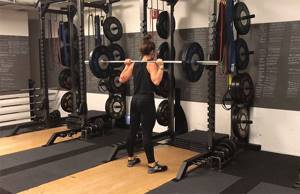
Technique for performing deep squats.
Deep squats - front grip
This version of the exercise is more suitable for experienced athletes.
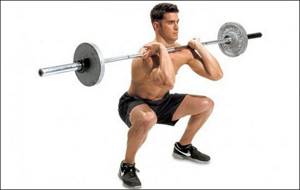
During squats, you can hold the barbell not on your shoulders, as most people are accustomed to, but also on your upper chest.
In this case, the barbell can be held with a direct grip, as in the photo above, or with a cross grip, as in the photo below.
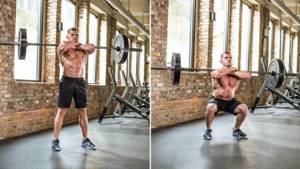
How to hold the barbell—with a straight or cross grip—depends on the athlete’s personal comfort.
In general, the technique is the same as during squats with a barbell on the shoulders, so we will not dwell on this in detail. Let's better talk about the exercise itself - whether it is worth it or not.
As we already mentioned, the load on the back, especially on the lower back, during deep squats is very significant, especially if there is additional weight on the shoulders, so it makes sense to try this version of the exercise to reduce the load in the back area.
Additionally, if you're looking to mix up your workout and try a really challenging variation of the squat, then this is the exercise for you.
If the exercise is difficult, the barbell can be replaced with dumbbells.
Number of repetitions: 8–12 in 3–4 sets.
How to properly perform barbell squats
Let's look at the technique of performing this movement in as much detail as possible.
View direction
You need to always look only in front of you. Quite often, beginning bodybuilders look down, but this should not be done. This is due to the fact that you can lose your balance, and also when you tilt your head forward, your back rounds.
Position of the projectile on the shoulders
The lower the bar is on your shoulders, the easier it will be for you to perform this movement. If you place the bar as high as possible, the quadriceps are worked just fine. Builders need to place the barbell high on their shoulders, but girls and powerlifters need it low.
Torso tilt
The tilt is to include/exclude various muscles in the work. Bodybuilders should not bend over deeply, but should try to keep their back in a vertical plane. It is quite clear that there will still be a slight tilt, because this will make it more comfortable for you to squat.
Deflection in the lumbar back
To avoid injury to the spinal column, it is necessary to maintain a natural arch in the lumbar region. It is for this reason that you should not look down, and the position of your legs should be comfortable for you.

Squat depth
The load on the gluteal muscles, as well as the lower back, depends on this parameter. To use them fully, squat as low as possible. Bodybuilders only need to go just below hip parallel to the ground.
Position of knee joints and feet
The knee joints should not extend beyond the level of the socks. If this happens, you move your pelvis far back and you may get injured. The wider the legs are, the more actively the buttocks are involved in the work and vice versa.
That's all the main nuances of the exercise. The breathing technique is similar to other movements - inhale while moving down, and exhale accordingly when going up.

In conclusion, here is an example of a leg training program:
- Squats – 4x6-10 (number of sets x number of repetitions).
- Deadlift - 4x6-10.
- Leg extensions in a sitting position - 4x6-10.
- Leg bends in a lying position - 4x6-10.
If you are limited in time and do not have time to complete all these movements, then just squats with a barbell will be enough.
What is the harmful effect?
Unfortunately, the squat exercise, in addition to its benefits, also has harm, this is especially important for women. As our grandmothers say, “you still have to give birth!”
Yes, indeed, women shouldn’t get too carried away with super-high weights. And, most importantly, the correct execution technique plays a huge role here. If you don’t follow it, any benefit goes to waste.
- When we talked about what squats do for girls, we mentioned strengthening joints and ligaments. But, if you overdo it with weights, the opposite effect occurs - the risk of sprains and injuries. The knees are especially affected - over time, the joints can become inflamed and abrasion of the cartilage tissue will occur.
- Excessive axial load on the musculoskeletal system can cause intervertebral hernia or damage to the Achilles tendon.
- The question “are squats good for overweight women” is controversial, because it is a kind of load on the joints. Therefore, if you are obese, you should squat with an elastic bandage wrapped around your knees, and not get carried away with a large number of repetitions. Practice moderation.
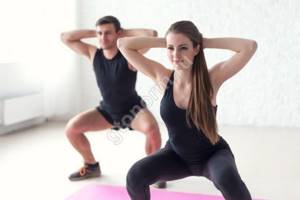
The latter applies to all situations. Don't try to overload your body. Work with adequate weight and increase the load in stages. In this case, you will feel all the benefits of the exercise.
Well, now you know how squats are beneficial for a girl’s health, and you are also warned about possible harmful consequences. To avoid them. Don't forget to squat correctly. Finally, let's talk about how to maximize your benefits.
Basic mistakes in squats
Mistakes often lead to ineffective exercises or even cause injury.
Pay attention to the most common ones:
- insufficiently warmed muscles, which is why they are not at all elastic and can even tear;
- shallow lowering of the pelvis during air squats, so the legs and buttocks do not receive the necessary load;
- a rounded back is fraught with lower back injuries;
- knees fall inward;
- incorrectly selected posture without taking into account anatomical features;
- dangling arms that do not participate in maintaining balance;
- a body that leans forward or backward;
- the additional weight is incorrectly chosen - too small or too large;
- squats with a barbell without insurance;
- lowering the pelvis too quickly;
- sudden movements;
- lack of coordination of movements when body parts or projectiles “walk” from side to side;
- lack of concentration on the working muscles, which can lead to serious mistakes.
Video: 5 mistakes when doing squats
Based on the above, we can conclude that squats are one of the most effective exercises for training the lower body. It is basic in any sport. By regularly squatting, you can not only improve your physical condition, but also give your body an attractive appearance.
Squats for women
Squats are the best exercise for girls who want to get a feminine figure.
Bodybuilding squats for women will look like this:
Workout #1
| Exercise | Weight | Approaches | Repetitions | Rest minutes between sets |
| Squats | 20 | 3 | 10 | 2 |
Workout #2
| Exercise | Weight | Approaches | Repetitions | Rest minutes between sets |
| Squats | 20 | 4 | 10 | 2 |
Workout #3
| Exercise | Weight | Approaches | Repetitions | Rest minutes between sets |
| Squats | 20 | 5 | 10 | 2 |
Workout #4
| Exercise | Weight | Approaches | Repetitions | Rest minutes between sets |
| Squats | 20 | 5 | 12 | 2 |
Workout #5
| Exercise | Weight | Approaches | Repetitions | Rest minutes between sets |
| Squats | 22,5 | 3 | 12 | 2 |
Workout #6
| Exercise | Weight | Approaches | Repetitions | Rest minutes between sets |
| Squats | 22,5 | 4 | 12 | 2 |
Workout #7
| Exercise | Weight | Approaches | Repetitions | Rest minutes between sets |
| Squats | 22,5 | 5 | 12 | 2 |
Workout #8
| Exercise | Weight | Approaches | Repetitions | Rest minutes between sets |
| Squats | 25 | 3 | 12 | 2 |
Workout #9
| Exercise | Weight | Approaches | Repetitions | Rest minutes between sets |
| Squats | 25 | 4 | 12 | 2 |
Workout #10
| Exercise | Weight | Approaches | Repetitions | Rest minutes between sets |
| Squats | 25 | 4 | 15 | 2 |
Workout #11
| Exercise | Weight | Approaches | Repetitions | Rest minutes between sets |
| Squats | 25 | 5 | 15 | 2 |
Workout #12
| Exercise | Weight | Approaches | Repetitions | Rest minutes between sets |
| Squats | 27,5 | 3 | 15 | 2 |
We continue to increase the weight, the number of approaches and repetitions in a similar mode.
Comments:
- We specifically showed squats in dynamics, since lack of progress is the main problem of 95% of girls who come to the gym. The same applies to men. We think that since the fifth point is torn off the sofa and works when doing squats, its appearance will improve by leaps and bounds. This is a misconception: training without progressive loads only allows you to stay in shape. Real bodybuilding squats - progression squats;
- You can progress less often. Step every 1-4 workouts;
- Using these schemes, you can improve the appearance of your buttocks and legs, as well as burn fat. A lot depends on nutrition.
Basic mistakes when doing squats
The correct exercise technique helps to maximally work out the muscles that work when squatting and minimizes the risk of injury due to the increased load on the back and knee joints. To make the exercise as safe as possible, familiarize yourself with the main mistakes when performing it and try not to make them.
- Knees extending beyond the toes. A fairly popular mistake among beginners. The danger is that the joints are over-stressed, increasing the risk of sprains and injury. Let your knees be in line with your toes.
- Excessive relaxation of the shoulders and back. If your back automatically rounds when squatting, you need to work on it. If it is level, the spine is in a neutral position, making the exercise safe and effective. To do squats, you already know which muscles work, and work your core, you can lower your shoulder blades down a little.
- Insufficient squat depth. Many beginners are deeply afraid of squatting, because they believe that this increases the risk of knee injury. In fact, if you do everything correctly, there is no danger in this, but the effectiveness is very good. Watch how low your hips go: they should go below knee level. Then squats, which muscles are involved you know, will be as effective as possible.
- Insufficient regularity of squats. It is recommended to include squats in every workout, performing them at least 2-3 times a week. To work different muscle groups when doing squats, combine different types of them.
Let's look at how to properly perform a classic squat using your own weight. This technique involves the following nuances:
- Stand straight with your feet slightly wider than shoulder-width apart.
- Shift your weight into your heels and arches.
- Your knees should be over your ankles and your hips over your knees.
- As you move, keep your spine in a neutral position. He shouldn't overexert himself.
- You need to extend your arms in front of you and place them in a position parallel to the floor. Palms should be facing down.
- Inhale and begin to slowly move your hips back, bending your legs.
- Look forward at one point, keep your back straight, do not round it or lower your shoulders.
- As the squat deepens, focus on keeping your feet and knees in line.
- Try to go as low as you can. You can lower your hips to knee level or lower.
- Returning to the starting position, push off with your heels. This will help to engage the core muscles in the exercise. published econet.ru.
Execution Rules
It is worth considering the exercise in the classic version , where your own weight is used. Once you learn this technique, you will be able to perform other types of squats without any problems.
- Stand straight with your feet slightly wider than your shoulders. Shift your weight into your heels and into your arches.
- Knees over ankles, hips over your knees. When moving, the spine should remain in a neutral position, do not strain it.
- Extend your arms in front of you, they will be parallel to the floor. Point your palms down. Inhale, begin to push your hips back, slowly bending your legs.
- Look straight at one point, straight back, don’t let your shoulders drop. As you deepen your squat, watch your knees and feet—they must remain in line!
- Go as low as you can. You can lower your hips to knee level or lower if you can.
- Push through your heels as you return to the starting position. Then the core muscles will also be involved in the work.
Squats are an effective and at the same time very simple exercise. With its help, you can work out the muscle groups you need, forming a beautiful and toned body that will definitely evoke admiring glances. Remember to perform them regularly, do not forget about safety precautions, then positive results will not be long in coming. Try it - this is the only way to be sure of the effectiveness of the activities, for which you do not necessarily have to leave your home.
Originally posted 2018-01-29 11:56:34.
